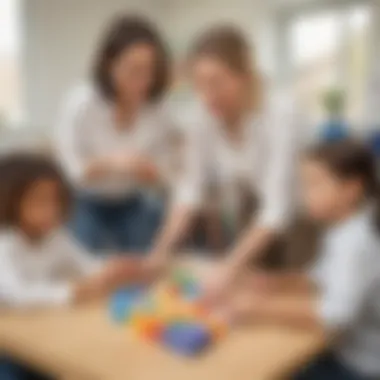Understanding the Tens Block: A Key Tool in Early Math


Intro
In early mathematics education, tools that simplify abstract concepts hold immense value. The tens block serves a monumental role in making the complex nature of numeracy more accessible to young learners. Understanding its significance goes beyond mere possession of a tactile object; it opens doors to deeper comprehension of place value and arithmetic.
Main Purpose
This guide aims to articulate a comprehensive understanding of the tens block, detailing methods of integration in learning units for children aged three to twelve. Educators and parents can significantly influence young learners through strategic application of this educational tool. There is much to learn regarding the advantages, applications, and pedagogical theories that underpin effective teaching with tens blocks. Here, we emphasize the broader impact on children’s mathematical development.
Interactive Learning Games
Incorporating interactive learning games enhances experience around the use of tens blocks. Through games, concepts related to place value and arithmetic operations become more engaging for children. Here are some popular games that educators and parents can consider integrating:
Popular Games
- Tens Block Bingo: Combines the excitement of bingo with number recognition.
- Build the Block: This game helps children visualize constructing numbers using tens blocks.
- Go Fish: A version of the classic card game that focuses on matching numbers and understanding pairs of tens.
Benefits of Playing Educational Games for Kids' Cognitive Development
Gaming offers numerous cognitive learning benefits, including:
- Enhanced problem-solving skills
- Improved memory retention
- Encouraged collaboration and teamwork in group settings
“Games offer an engaging platform that deeply embeds mathematical concepts.”
Tips and Tricks
Practical approaches can maintain an enjoyable and effective learning journey for children. Here are several strategic suggestions for educators and parents:
- Encourage exploration with minimal guidance, allowing children to discover solutions independently.
- Create a routine that incorporates tens block activities regularly, building familiarity and confidence.
- Mix play with learning. Use tens blocks in playful contexts where kids can like numbers and math tasks smoothly.
Creative DIY Projects
Constructing DIY projects around tens blocks invites creativity while enhancing learning. Step-by-step guides for hands-on learning can translate math challenges into fun tasks.
Step-by-Step Guides
- Creating a Tens Block Box: Used for sorting various numbers and enhancing manipulatives for place value understanding.
- Number Road with Tens Blocks: Provide a visual path representation of numbers, reinforcing partitioning and grouping.
Craft Ideas
Hands-on activities using simple household items allow children to further express themselves, smashing the boundaries of traditional learning:
- Color-code the blocks for visual learning experiences.
- Use clay to shape numbers alongside the tens blocks.
Integrating art and number activities can seize children’s interest and foster deeper learning engagement. This synthesis of creative and math learning equips children for sparking curiosity.
Prelims to Tens Block
The tens block serves as a pivotal element in early mathematics education. It provides young learners with a tangible means to grasp essential mathematical concepts. Understanding the structure and function of the tens block allows educators and parents to effectively engage children in their mathematical journey. This tool not only aids in comprehension of place value but also enhances skills such as addition and subtraction. The goal is to ensure that children from age three to twelve interact with mathematics in a way that feels intuitive and supportive.
Definition and Purpose
A tens block, often in the form of interlocking units, represents ten single units in a tangible way. It visually illustrates the transition between single digits and values in double digits. When children utilize these blocks, they physically manipulate numbers, helping them make connections to abstract concepts. This forms a cornerstone for their further studies in mathematics.


The primary purpose of using a tens block is to introduce and reinforce the concept of place value. For instance, the digit's position in a number signifies its value; understanding this is crucial for mastering arithmetic later on. Thus, the tens block is not merely a learning aid; it encapsulates fundamental mathematical principles vital for children.
Historical Context and Development
The development of the tens block is closely tied to shaping early math teaching practices. Historically, mathematics has transitioned from purely oral traditions to the incorporation of tangible tools. In many educational settings, especially those grounded in hands-on learning, tens blocks have found significant applications.
The effective use of the tens block began taking root during the 20th century, coinciding with updated pedagogical theories emphasizing active participation. As educators recognized the limits of rote memorization for young minds, the focus shifted to the development of understanding through immersive strategies. Lakes and Lott, in the 1960s, proposed the integration of manipulatives— like tens blocks— to cultivate mathematical reasoning.
Today, tens blocks remain fundamental in classrooms worldwide. You can find them in primary education settings, where the curriculum actively seeks to engage students in problem-solving and critical thinking. It reflects broader educational shifts, acknowledging that every child learns differently and must engage with mathematical concepts in diverse ways.
The Role of Tens Blocks in Mathematics Education
The utilization of tens blocks serves as an essential element in mathematics education. Their deployment supports multiple facets of learning, empowering both educators and parents to foster a deeper understanding of mathematical concepts among young learners. Through a hands-on approach, tens blocks are not merely tools; they create a tangible experience that enhances comprehension.
Understanding Place Value
Place value is a fundamental concept in mathematics that illustrates how the position of a digit affects its value. Tens blocks directly address this principle by visually depicting the base-ten system. Each block usually represents ten units, allowing students to grasp the significance of scaling. When learners manipulate tens blocks, they gain clarity on how numbers transform when they are repositioned or regrouped.
By interacting with these blocks, students understand that the digit '3' in the number '30' actually represents ‘three sets of ten’. This not only deepens their concept of place value but also prepares them for more advanced operations. Additionally, learners can often relate better to physical objects than abstract symbols, which enhances engagement.
Facilitating Addition and Subtraction
Tens blocks also play a critical role in introducing addition and subtraction. They allow for concrete strategies when performing operations. For instance, when adding two numbers, students can physically combine blocks to visualize the process. This minimizes confusion over concepts, transforming abstract math into an interactive experience. For instance, if a student needs to add 28 and 15, they can represent both numbers with tens blocks, combining them to see how the total develops.
For subtraction, students can use tens blocks as well to illustrate the process of taking away. They often find it hard to understand
Educational Benefits of Using Tens Blocks
The use of tens blocks offers significant educational advantages that enhance mathematical understanding. These manipulatives serve as instruments that bridge conceptual gaps, making abstract mathematical ideas more tangible for young learners. Through this section, we explore three major benefits that thousands of educators and parents can observe first-hand: enhancing cognitive development, promoting problem-solving skills, and encouraging collaborative learning.
Enhancing Cognitive Development
Tens blocks effectively enhance cognitive development in children by engaging multiple brain functions. When students interact with these manipulatives, they visualize numbers in physical forms. This representation helps them internalize the concept of place value, leading to deeper mathematical understanding.
The hands-on experience with tens blocks supports spatial reasoning abilities. Such skills are essential not only for math but also for various other subjects. For example, when a child replaces a tens block with ten single units, they radically grasp the idea that the ten units can be regrouped. Regrouping nurtures flexibility in thinking, important for algebra and higher-level math tasks.
Additionally, the multisensory approach tends to capture and retain the child’s attention better than traditional methods. This engagement often results in improved focus and mental stamina during math activities.
Promoting Problem-Solving Skills
Problem-solving is a critical life skill; tens blocks provide an ideal platform for developing this competency in young learners. When kids solve additon or subtraction problems using tens blocks, they investigate and strategize. They can physically manipulate the blocks to see the changes that occur when they combine numbers, which fosters analytical thinking.
For example, while working on a problem such as 23 + 17, children can create both 20 as a block and 3 single units for the number 23. Thus, they break down the numbers into manageable parts.
In real-world scenarios, having solid problem-solving abilities assists students in making successful decisions in diverse aspects of life. Therefore, capturing this skill during formative years is paramount.
Encouraging Collaborative Learning
Collaboration among peers enhances the learning process. By using tens blocks, students can share strategies. They can discuss how to approach problems, observe different solutions, and reinforce their thinking through social interaction.
Notably, group activities can encourage peer teaching. A child who understands a specific mathematical concept might help others by demonstrating with tens blocks. This exchange of knowledge not only reinforces the tutor's understanding; it also solidifies the concepts for those receiving help.
Creating an environment where students use tens blocks together fosters mutual respect and communication. Such an environment aligns with current pedagogical trends that recognize the value of collaborative learning in the classroom.
"Manipulatives like tens blocks are not just tools; they are bridges. Bridges that connect learners to abstract mathematics through concrete experiences."


The educational benefits obtained through the use of tens blocks pave the way for robust development in cognitive skills, problem-solving techniques, and collaborative efforts. Understanding these benefits can reshape how educators and parents approach early mathematical learning.
Implementing Tens Blocks in Classroom Settings
Implementing tens blocks in classroom settings is a vital element of enhancing mathematical understanding among young learners. Tens blocks provide a concrete way for children to explore important concepts such as place value and basic arithmetic operations. By utilizing these tools effectively, teachers can transform their pedagogical approaches to mathematics, tailoring their methods to fit the unique needs of each student. Through practical engagement, tens blocks serve not only as manipulatives but as means to foster deeper cognitive connections.
Choosing the Right Tens Block Tools
Selecting appropriate tens block tools is critical for achieving desired learning outcomes. Different types of tens blocks exist; they can be made from wood, plastic, or cardboard. Educators need to evaluate their classrooms to determine which material best suits the age and maturity of the students.
- Wooden Blocks: They're durable and provide a tactile experience.
- Plastic Sets: Often lightweight and come in varied colors that may attract children.
- Cardboard Blocks: These may be less expensive but could wear out quicker than other materials.
In addition, the sizing and tactile aspect of blocks are significant considerations. Small blocks may be better suited to younger students, while larger sets may enhance visibility and engagement for all ages. Suitable tens blocks can empower students to grasp abstract ideas with tangible solutions.
Effective Teaching Strategies
To harness the power of tens blocks effectively, teachers must adopt targeted teaching strategies that nurture both comprehension and enthusiasm for math. Several key approaches can be implemented:
- Modeling Techniques: Demonstrating addition, subtraction, multiplication, and division using tens blocks can normalize these operations. This introduces transparency in mathematical processes for students.
- Guided Lessons: Offer structured yet flexible lessons, allowing children to explore problems individually or in pairs while receiving constructive math talk support.
- Interactive Games: Incorporating games, like
Tens Blocks in Home Learning Environments
Tens blocks hold a significant place, not just in the classroom but also in the home learning environment. Parents and caregivers need to understand their role in a child’s early mathematics education. Utilizing tens blocks can transform a mundane learning experience into an engaging and effective one. These tools help maintain children's interest while building foundational math skills.
Creating a Math-Friendly Space
A math-friendly environment encourages children to explore and engage with numerical concepts. This can be established by designating specific areas in the home where learning can occur comfortably. Setting up a dedicated learning corner can aid in this process. Consider these key factors:
- Declutter: Keep the space organized. Too many toys or distractions can deter focus.
- Proper Lighting: Ensure that the area is well-lit. A bright space promotes positive feelings towards learning.
- Access to Resources: Store tens blocks, books, and other math-related materials within reach.
In such environments, children may naturally gravitate toward the tens blocks, driven by curiosity. This demonstrates that a structured space can generate excitement about math.
Engaging Activities for Parents and Children
Family involvement is critical for enhancing a child’s mathematical journey. Parents can introduce engaging activities using tens blocks in ways that are both fun and educational. Here are a few ideas:
- Building Numbers: Parents can encourage children to construct numbers using blocks. This solidifies an understanding of place value as they physically manipulate groups of ten.
- Simple Addition and Subtraction: Create simple games where children use tens blocks to solve basic equations. This hands-on approach is easy for them to understand.
- Pattern Creation: Use blocks to develop patterns. This activity cultivates higher-level thinking.
These activities invite collaboration between children and caregivers, facilitating a unique learning experience that can strengthen their bond.
Balancing Play and Learning
Striking the right balance between play and education is vital. Engaging children with tens blocks should feel like play, not a chore. Consider implementing a mix of structured activities with free play. Incorporating flexible times for exploration will appeal more naturally to a child's sense of curiosity. Here are some strategies for maintaining this balance:
- Set Clear Limits: While free play is important, setting time limits ensures that learning does not become monotonous.
- Encourage Improvisation: Allowing children to invent their games keeps their interest piqued.
- Observe and Adapt: Monitor how your child engages with the tens blocks, and be ready to adjust activities based on their enthusiasm levels.
Effective home learning occurs when children feel free to learn through experiences without pressure.
Through solutions like these, parents can create an enriching environment that fosters both enjoyment and understanding in mathematics.
Challenges and Solutions in Using Tens Blocks
Using Tens Blocks as teaching tools offers many benefits, but it also comes with certain challenges. Obstacles may hinder their effectiveness in classroom and home settings. Therefore, addressing these issues is paramount in unlocking the full educational potential of Tens Blocks. Understanding common misconceptions and the diverse needs of learners can improve educational outcomes.


Common Misconceptions About Tens Blocks
One prevalent misconception is that Tens Blocks are only for younger children. Many people think that these manipulatives can’t contribute meaningfully at upper grade levels. In fact, they are beneficial beyond early exploration. They foster deepens students' understanding of abstract mathematical concepts. For example, concepts such as regrouping can still utilize Tens Blocks effectively at later stages of education.
Another misconception is that using Tens Blocks takes up too much class time. On the contrary, when used efficiently, they can save time in the long run. By solidifying foundations in place value, Tens Blocks help reduce the difficulty faced by children when they encounter more complex topics. Educators should present these blocks as necessary tools, not just small toys.
Additionally, some believe that once a child learns the basics with Tens Blocks, they no longer need them. This is misleading. These blocks serve as a bridge between tactile learning and mental math skills, providing an essential connection to abstract concepts.
Addressing Diverse Learning Needs
When implementing Tens Blocks, educators and parents must recognize that learners have varied ability levels and styles. Differentiation is key to adapting these tools to meet individualized needs.
Effective approaches include:
- Small Group Instruction: Creating small groups ensures that children receive attention tailored to their proficiency levels. This environment allows children who grasp concepts quickly to assist their peers.
- Multi-Sensory Techniques: Incorporating visual, auditory, and tactile experiences during lessons helps reinforce learning. For instance, students might explain their thought processes while manipulating Blocks.
- Encourage Self-Paced Learning: Providing opportunities for children to explore Tens Blocks independently can promote ownership of their learning. Children should feel free to experiment with different strategies at their own speed.
Importantly, progress monitoring through continuous assessments aids in recognizing when a student may need additional support. Feedback should be delivered tactfully, promoting a growth mindset that embraces trial and error.
Recognizing misconceptions and embracing diverse learning needs is essential for realizing the full potential of Tens Blocks as valuable educational resources.
Assessing Learning Outcomes with Tens Blocks
Assessing learning outcomes with tens blocks is vital in understanding how effectively this teaching tool supports children's math skills. It provides an analysis of students' grasp of essential mathematical concepts. Proper assessment strategies can inform educators about each child's progress and diverse learning needs. The use of tens blocks can directly influence their ability to arrive at answers through a hands-on approach, permitting a more significant comprehension of mathematical principles.
Formative Assessment Techniques
Formative assessments are designed to monitor student learning and provide ongoing feedback that can be used by instructors to improve their teaching and help students improve their learning. In the context of tens blocks, some effective formative assessment techniques include:
- Observation: Regularly observe how children interact with the tens blocks. It brings to light their understanding of number relationships and spatial reasoning. Note how they use these blocks for problem-solving.
- Questioning: Asking targeted questions during activities can reveal a student's thinking process. Questions might focus on their choices during the activity or pose hypothetical scenarios involving tens blocks.
- Exit Tickets: At the end of lessons, having students answer one or two questions about what they learned regarding tens blocks culminates their knowledge effectively. This can help assess their immediate understanding.
Incorporating these techniques offers educators insights into not only children's mathematical knowledge but also their engagement and approach to learning.
Feedback Mechanisms and Improvement
Feedback is essential to the learning process. In utilizing tens blocks, effective feedback mechanisms can create multiple avenues for improvement. These include:
- Individual Feedback: After observed activities, educators should provide feedback to each child, pointing out specific areas where they can improve, like understanding equality and predicting outcomes through the use of tens blocks.
- Peer Feedback: Encourage students to discuss their processes and solutions with one another. This can enhance their critiques and promote collaborative learning environments.
- Iterative Feedback: Repeatedly gauge progress using tens blocks over various lessons can illuminate areas of growth as well as constant challenges. Adjusting the instructional methods based on this ongoing feedback yields tremendous potential for refinement.
Feedback is the bridge between what students know and where they need to go next.
By applying these feedback mechanisms, educators can pave the way for continuous growth. Assessing learning outcomes with tens blocks thus becomes an essential part of enhancing mathematical understanding in young learners. Through consistent observation, effective formative assessment techniques, and constructive feedback, both educators and parents can collaboratively nurture and track the mathematical progress of children.
End
The conclusion of this article plays a crucial role in summarizing the findings on the tens block and its implications for early mathematics education. It synthesizes the critical insights presented throughout the article and confirms the importance of applying tens blocks in teaching strategies. When used effectively, tens blocks help pave the way for deeper comprehension of mathematical concepts.
Recap of Key Insights
Throughout the article, several key insights reveal the significance of tens blocks in education:
- Foundation for Math Skills: Tens blocks facilitate a clear and practical understanding of place value, which is integral for more advanced arithmetic.
- Enhanced Learning Experience: The manipulable nature of tens blocks promotes active engagement, essential for retention and understanding among young learners.
- Diverse Applications: Tens blocks are versatile tools suitable not only for teaching addition and subtraction but also for multiplication, division, and place value concepts.
These insights demonstrate how tens blocks can be integral to creating a well-rounded math education for children. When educators and parents understand these concepts, they can implement strategies that promote not just rote learning but a deeper grasp of mathematics.
Future Directions in Math Education
Looking forward, it is clear that integrating tools like tens blocks will continue to evolve. The following are potential future trends in math education:
- Increased Customization: Educators will likely pursue tailored methods to use tens blocks that address individual student needs. Understanding diverse learning styles can help optimize the tool’s use.
- Technological Integration: The fusion of traditional tools and technology will become more prominent. Digital applications could simulate tens block manipulation, making it easier for children to learn remotely.
- Focus on Collaborative Learning: Instruction will continue to shift towards collaborative learning environments, leveraging tens blocks to encourage student interaction. This method can enhance peer discussions and drive engagement.
In summary, the conclusion emphasizes the broad reach and applicability of tens blocks within math education frameworks. As this field progresses, maintaining a focus on versatile teaching tools can further develop children's cognitive capabilities in mathematics.















